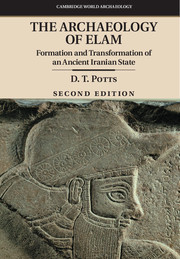Book contents
- Frontmatter
- Dedication
- Contents
- List of illustrations
- List of tables
- Preface to the second edition
- Preface and acknowledgements
- Acknowledgements for photographic reproduction
- List of abbreviations
- Note on transliteration and dating systems
- 1 Elam: what, when, where?
- 2 Environment, climate and resources
- 3 The immediate precursors of Elam
- 4 Elam and Awan
- 5 The dynasty of Shimashki
- 6 The grand regents of Elam and Susa
- 7 The kingdom of Susa and Anshan
- 8 The Neo-Elamite period
- 9 Elam in the Achaemenid empire
- 10 Elymais
- 11 Elam under the Sasanians and beyond
- 12 Conclusion
- References
- Index
8 - The Neo-Elamite period
Published online by Cambridge University Press: 18 December 2015
- Frontmatter
- Dedication
- Contents
- List of illustrations
- List of tables
- Preface to the second edition
- Preface and acknowledgements
- Acknowledgements for photographic reproduction
- List of abbreviations
- Note on transliteration and dating systems
- 1 Elam: what, when, where?
- 2 Environment, climate and resources
- 3 The immediate precursors of Elam
- 4 Elam and Awan
- 5 The dynasty of Shimashki
- 6 The grand regents of Elam and Susa
- 7 The kingdom of Susa and Anshan
- 8 The Neo-Elamite period
- 9 Elam in the Achaemenid empire
- 10 Elymais
- 11 Elam under the Sasanians and beyond
- 12 Conclusion
- References
- Index
Summary
The Neo-Elamite period (for the first use of this term in a linguistic sense, see Hüsing 1898: 1, 1908b: 3, 7) is dated from c. 1000 BC until the conquest of Babylonia in 539 BC by Cyrus the Great. For simplicity we have divided it into three phases. While the earliest phase (Neo-Elamite I, c. 1000–744 BC) is poorly known, the middle phase (Neo-Elamite II, 743–646 BC) is amply documented in Assyrian sources, for it was a period of intense conflict between the Assyrian kings and a series of Elamite rulers, often allied with insurrectionists in southern Babylonia. The inscriptions of Shutruk-Nahhunte II (c. 717–699 BC) from Susa reveal continuities with earlier periods in Elamite history, but much of the contemporary archaeological material from the site is badly disturbed. Similarly, it is impossible to correlate much of the military history of Assyria's aggression with Elamite archaeology for the simple reason that many of the towns in western Khuzistan which must have borne the brunt of Assyrian aggression have yet to be identified on the ground, let alone excavated (see in general Carter 2007; for the historical geography of this period see Parpola and Porter 2001). It is also likely that, under intense Assyrian pressure, Elam as it had existed in the Middle Elamite period was no longer a unified state comprising both the highlands of Fars and the lowlands of Khuzistan, and it is possible that individual cities, such as Hidalu or Madaktu, were not bound by the authority of a single Elamite king (but note the reservations of Henkelman 2003c: 253 on this point).
It is clear that, given the paucity of indigenous Elamite sources at this time, we are to some extent a prisoner of the Assyrian royal inscriptions and the Babylonian Chronicle which present us with a sequence of Elamite rulers through foreign eyes. In this regard it is important to note that the scarcity of references to Anshan at this time leaves us in the dark about contemporary historical events in the highlands. Rock reliefs at Kul-e Farah and Shikaft-e Salman seem to relate to petty kings in the highlands who wrote in Elamite but whose relationship to the Elamite kings mentioned in Assyrian and Babylonian texts is generally obscure.
- Type
- Chapter
- Information
- The Archaeology of ElamFormation and Transformation of an Ancient Iranian State, pp. 249 - 306Publisher: Cambridge University PressPrint publication year: 2015

